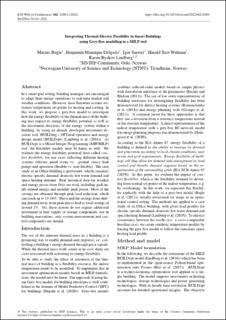| dc.contributor.author | Bagle, Marius | |
| dc.contributor.author | Manrique Delgado, Benjamin | |
| dc.contributor.author | Sartori, Igor | |
| dc.contributor.author | Walnum, Harald Taxt | |
| dc.contributor.author | Lindberg, Karen Byskov | |
| dc.date.accessioned | 2022-12-05T07:05:29Z | |
| dc.date.available | 2022-12-05T07:05:29Z | |
| dc.date.created | 2022-12-02T09:37:52Z | |
| dc.date.issued | 2022 | |
| dc.identifier.issn | 2267-1242 | |
| dc.identifier.uri | https://hdl.handle.net/11250/3035725 | |
| dc.description.abstract | In a smart grid setting, building managers are encouraged to adapt their energy operations to real-time market and weather conditions. However, most literature assume stationary temperature set points for heating and cooling. In this work, we propose a grey-box model to investigate how the energy flexibility of the thermal mass of the building may impact its energy flexibility potential as well as the investment decisions of the energy system within a building, by using an already developed investment decision tool, BUILDing’s OPTimal operation and energy design model (BUILDopt) (Lindberg et al. (2016)). As BUILDopt is a Mixed Integer Programming (MIP/MILP) tool, the flexibility models must be linear as well. We evaluate the energy flexibility potential, here called comfort flexibility, for use cases reflecting different heating systems (electric panel ovens vs. ground source heat pump) and operation (flexible vs. non-flexible). The case study of an Office building is performed, which considers electric specific demand, domestic hot water demand and space heating demand. Real historical data for weather and energy prices from Oslo are used, including grid tariffs related energy and monthly peak power. Most of the savings are obtained through peak load reduction, which can reach up to 13-16%. These and the savings from shifting demand away from peak prices lead to total savings of around 2%. Yet, these actions do not require additional investment in heat supply or storage components, nor in building renovations: only system measurement and control components are needed. | en_US |
| dc.language.iso | eng | en_US |
| dc.publisher | E3S Web of Conferences | en_US |
| dc.relation.ispartofseries | BuildSim Nordic 2022 | |
| dc.rights | CC BY 4.0 | * |
| dc.rights.uri | http://creativecommons.org/licenses/by/4.0/ | * |
| dc.title | Integrating Thermal-Electric Flexibility in Smart Buildings using Grey-Box modelling in a MILP tool | en_US |
| dc.title.alternative | Integrating Thermal-Electric Flexibility in Smart Buildings using Grey-Box modelling in a MILP tool | en_US |
| dc.type | Peer reviewed | en_US |
| dc.type | Journal article | en_US |
| dc.description.version | publishedVersion | en_US |
| dc.rights.holder | © 2022 The authors | en_US |
| dc.subject.nsi | VDP::Teknologi: 500 | en_US |
| dc.source.volume | 362 | en_US |
| dc.source.journal | E3S Web of Conferences | en_US |
| dc.identifier.doi | 10.1051/e3sconf/202236212003 | |
| dc.identifier.cristin | 2087575 | |
| dc.relation.project | Norges forskningsråd: 257660 | en_US |
| dc.relation.project | Norges forskningsråd: 294920 | en_US |
| dc.source.articlenumber | 12003 | en_US |
| cristin.ispublished | true | |
| cristin.fulltext | original | |
| cristin.qualitycode | 1 | |

